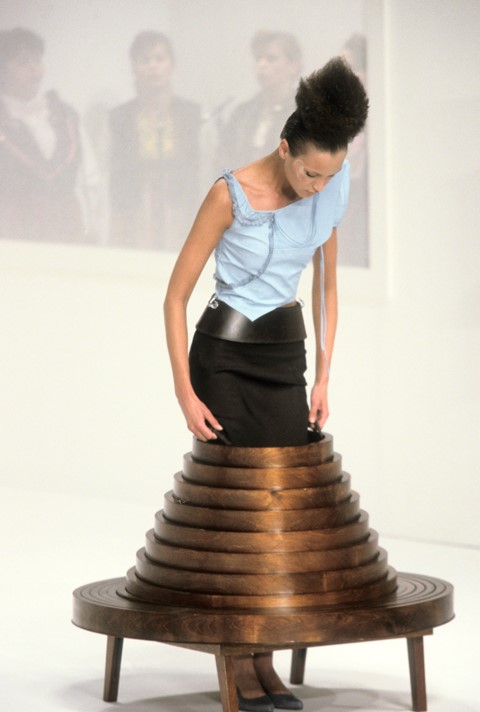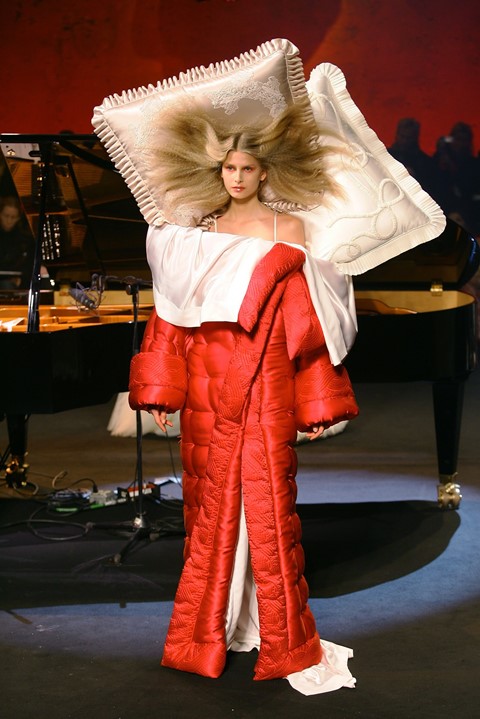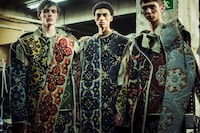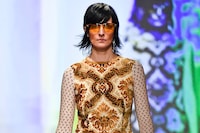Featuring work by Martin Margiela, Le Corbusier and Hussein Chalayan, MoMu’s thought-provoking new exhibition unpacks the relationship of fashion and interiors from a gendered perspective
In our hyperconnected landscape, sharing images of our interiors has become another form of curated self-portraiture, akin to hyper-stylised fashion pictures, offered up as (supposed) proof of taste, aesthetic literacy, a life well-lived. It feeds our voyeuristic impulse: that deeply human desire to see and be seen. But as MoMu’s latest exhibition, Fashion & Interiors: A Gendered Affair, curated by Romy Cockx, explores, this urge is far from new. Since at least the 19th century, fashion and interiors have collapsed into one another, often to the erasure of women.
An exhibition on fashion and interior design could easily have been a lovely celebration of tastemakers. After all, as a slideshow midway through the show – of fashion designers in their interiors – reminds us, they are often revered for their impeccable taste, their ability to shape not only clothes but entire lifestyles. But what Cockx does so cleverly, with such a wide-ranging subject, is to centre the woman at the heart of this entanglement – and then unpick the seams from her 19th-century passementerie dress to reveal just how cloaked she truly was within the affair.
Cockx found her foothold for the exhibition in the writings of design historians Penny Sparke and Beverly Gordon, who explore the conflation of women’s taste and interiors during the industrial age. The show opens with a striking juxtaposition: 19th-century paintings by Belgian artist Alfred Stevens placed alongside contemporary photographs by Patty Carroll, tracing how the interior “became a soft shell – a place for women to retreat from the filth and scrutiny of the outside world,” but also a space in which they were slowly absorbed. The ‘drape-mania’ of the era concealed women’s bodies in tiered garments while their homes, often dressed in the same fabrics, became an extension of their silhouettes.

The exhibition doesn’t unfold as a strict chronology but rather as an exploration of the ongoing push and pull between fashion and interior design – and, crucially, how women have navigated that tension. An extraordinary 3D rendering of a dress, developed from a historical pattern by Belgian designer Henry van de Velde for his wife, Maria Sèthe, reveals just how deeply he considered her an extension of his aesthetic world. The garment mirrors the simplicity of his Art Nouveau interiors; she, too, was designed to fit the room. Yet in contrast, Jeanne Lanvin’s black-and-white triangle dress, paired in the exhibition with a tiled bathroom bearing the same motif, signals a shift: from woman as decoration to woman as architect of taste.
One of the exhibition’s most quietly arresting moments is a site-specific installation by Martin Margiela, a designer long fascinated by the colour white. Early in his career, Margiela painted his entire interior white, not out of aesthetic minimalism but necessity. Unable to afford expensive furniture, white offered a kind of camouflage, a unifying veil of intention. As the exhibition suggests, it echoed Le Corbusier’s vision of white walls as purity and order, but here, the effect is ghostly, not gleaming. Margiela gestures to the home as a space not just of style, but of memory, disintegration, and disappearance; starkly contrasted with earlier works in the exhibition by Viktor&Rolf and Hussein Chalayan, which, as Cockx explains, “reflect on the fragility of the home as a place of privacy, security and comfort.”

This marks a shift in the exhibition from historical parallels to the full enmeshment of the two forms. The two disciplines no longer mirror one another but merge. Ann Demeulemeester’s garments, informed by the clean geometry and palette of her Le Corbusier-designed home in Antwerp, embody this collapse. The woman is no longer draped into her surroundings – but neither is she entirely unbound from them. As Cockx reflects, “I hope above all that fewer and fewer people feel trapped in their homes, clothes or bodies.”
Fashion & Interiors: A Gendered Affair is on show at MoMu – Fashion Museum Antwerp until 3 August 2025.






